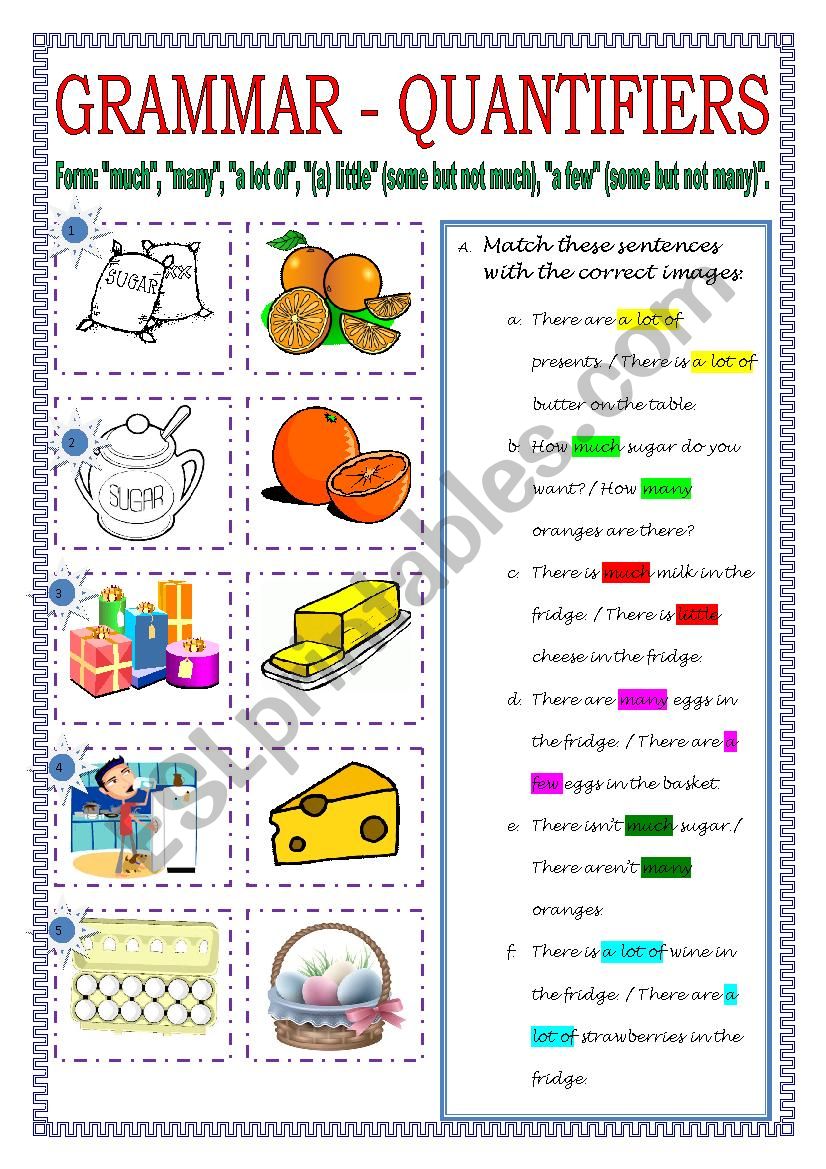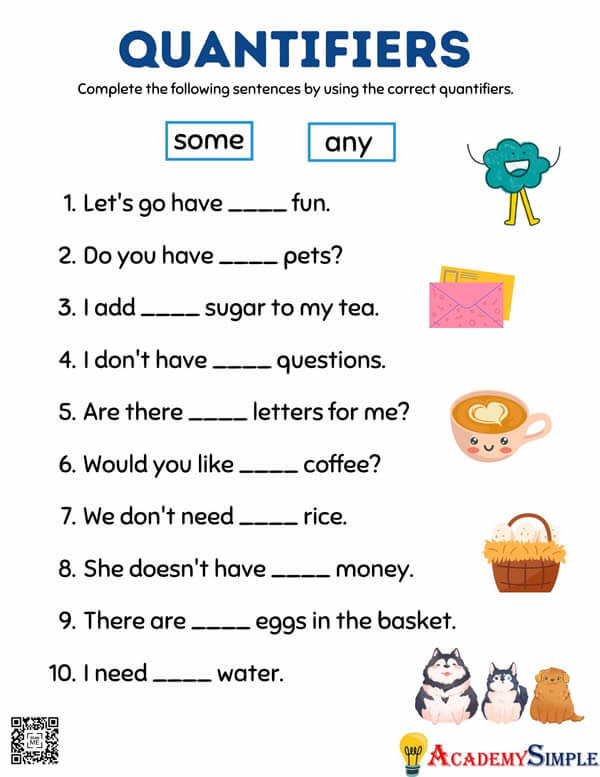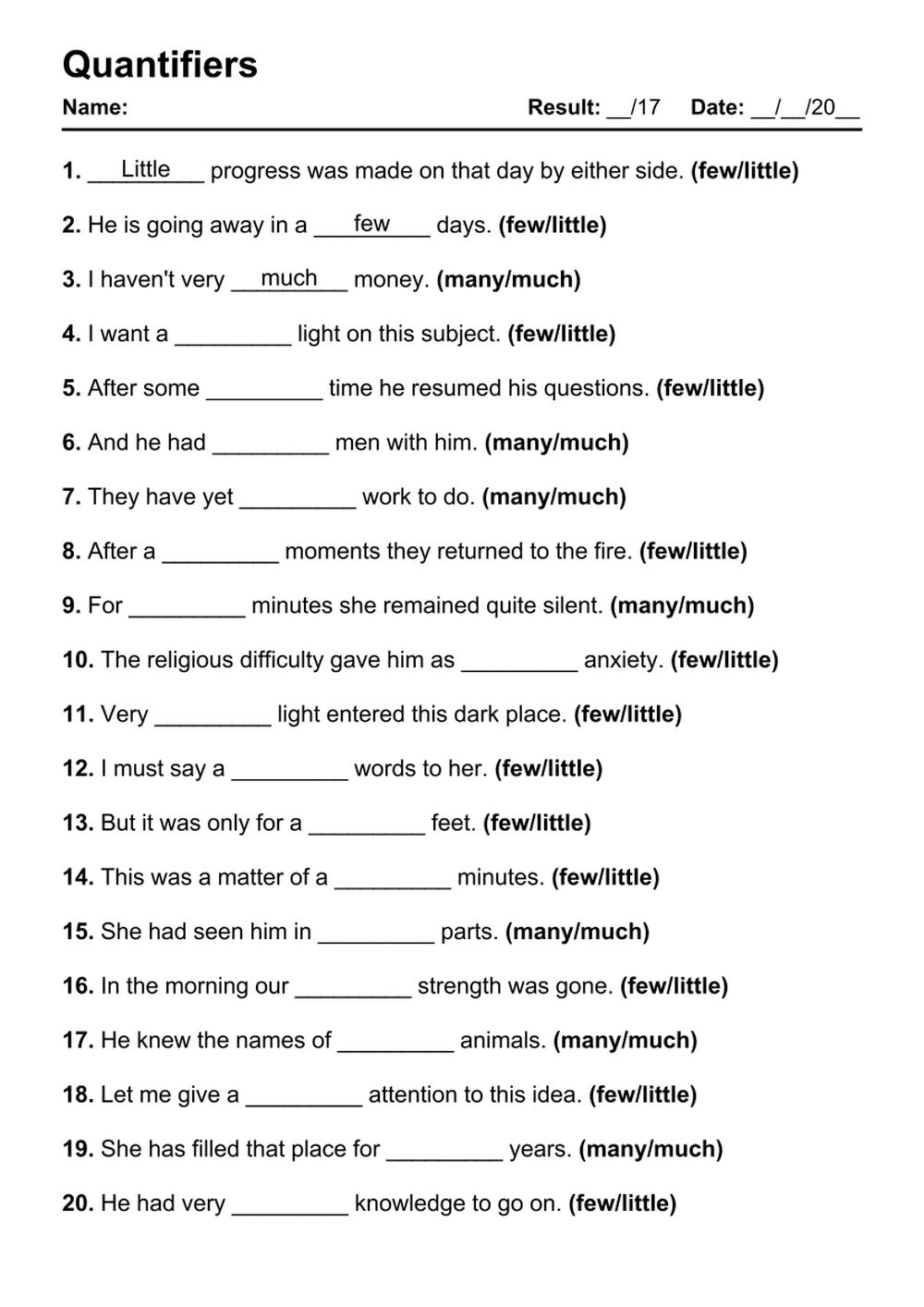
Mastering Quantity: The Indispensable Role of Grammar Worksheets: Quantifiers
Grammar, often seen as the skeleton of a language, provides the essential structure that allows us to communicate effectively and precisely. Among its many intricate components, quantifiers stand out as particularly crucial for conveying meaning related to amount, number, and degree. They allow us to distinguish between "a few apples" and "few apples," or "much money" and "many coins," nuances that significantly alter the message. For learners of English, mastering these subtle distinctions can be a significant hurdle. This is where Grammar Worksheets: Quantifiers become not just helpful, but truly indispensable tools in the learning journey.
Understanding Quantifiers: The Building Blocks of Quantity

Before delving into the utility of worksheets, it’s vital to grasp what quantifiers are and why they pose a challenge. Quantifiers are words or phrases that specify the amount or quantity of a noun. They tell us "how much" or "how many" of something there is.

Common quantifiers include:

- For countable nouns (things we can count individually, e.g., apples, chairs, students): many, a few, few, several, a number of, both, either, neither, every, each.
- For uncountable nouns (things we cannot count individually, e.g., water, information, advice, time): much, a little, little, a great deal of, a large amount of.
- For both countable and uncountable nouns: some, any, a lot of, lots of, plenty of, most, all, no, none.


The challenge lies in their specific usage rules. For instance, "much" and "many" are often replaced by "a lot of" in affirmative sentences in informal speech, but "much" is still common in negative sentences and questions with uncountable nouns ("I don’t have much time"). The distinction between "few" (implying scarcity or not enough) and "a few" (implying a small but sufficient number) is another common stumbling block, as is "little" vs. "a little" for uncountable nouns. These subtleties, while seemingly minor, can drastically change the intended meaning of a sentence, leading to miscommunication.
Why Are Quantifiers So Challenging for Learners?

Several factors contribute to the difficulty in mastering quantifiers:
- Countable vs. Uncountable Distinction: Many languages do not have as strict a distinction between countable and uncountable nouns as English does. This fundamental difference requires learners to re-categorize entire swaths of vocabulary, which can be counter-intuitive.
- Contextual Nuances: The choice of quantifier often depends on the context, the speaker’s intention, and even the tone. For example, "Any" is typically used in questions and negative statements, but can be used in affirmative sentences to mean "it doesn’t matter which."
- Negative and Positive Implications: The pairs "few/a few" and "little/a little" carry inherent positive or negative connotations that are not immediately obvious from their literal meaning.
- Collocations and Fixed Expressions: Some quantifiers appear in fixed expressions (e.g., "a great deal of trouble," "a number of options") that must be learned as chunks.
- Overlapping Usage: While "much" and "many" are quite distinct, "a lot of" and "plenty of" can often be used interchangeably for both countable and uncountable nouns, adding a layer of complexity for learners trying to establish clear rules.



Given these challenges, learners need structured, repetitive, and varied practice to internalize the rules and develop an intuitive understanding of quantifier usage. This is precisely where Grammar Worksheets: Quantifiers prove their invaluable worth.
The Indispensable Role of Grammar Worksheets: Quantifiers
Grammar Worksheets: Quantifiers are more than just busywork; they are carefully designed pedagogical tools that offer targeted practice, reinforce learning, and help identify areas needing further attention. Here’s why they are so crucial:
- Targeted Practice and Reinforcement: Worksheets provide focused exercises on specific quantifier rules. Instead of general grammar practice, learners can concentrate solely on distinguishing between "much" and "many," or "few" and "a few." This targeted approach helps solidify understanding and build confidence.
- Identification of Weaknesses: As learners complete the exercises, patterns of errors often emerge. A teacher or the learner themselves can quickly identify which specific quantifiers or rules (e.g., the countable/uncountable distinction) are causing the most trouble, allowing for focused remediation.
- Self-Paced Learning: Worksheets are excellent for self-study. Learners can work through them at their own pace, reviewing sections as needed, and checking their answers with an answer key (if provided). This fosters autonomy and allows for personalized learning experiences.
- Variety of Exercise Types: Effective Grammar Worksheets: Quantifiers incorporate diverse exercise formats, preventing monotony and appealing to different learning styles. This variety also ensures that learners engage with the material from multiple angles.
- Application of Rules: Beyond just memorizing rules, worksheets force learners to apply them in context. Filling in blanks, correcting errors, or transforming sentences requires active recall and application of the learned grammar points.
- Building Confidence: Successfully completing a worksheet provides a sense of accomplishment, boosting a learner’s confidence in their ability to use English correctly. This positive reinforcement is vital for continued motivation.
- Assessment and Progress Tracking: For teachers, worksheets serve as quick assessment tools to gauge class understanding. For learners, they offer a tangible record of progress over time.
Types of Exercises Found in Effective Grammar Worksheets: Quantifiers
A well-designed set of Grammar Worksheets: Quantifiers will feature a range of exercise types to engage learners and thoroughly test their understanding. These might include:
- Fill-in-the-Blanks: The most common type, where learners choose the correct quantifier from a given list or generate one independently to complete sentences.
- Example: "There isn’t __ milk left in the fridge." (much/many)
- Multiple Choice: Learners select the best quantifier from several options provided. This tests recognition and understanding of nuances.
- Example: "She has (a few/few) friends, so she often feels lonely."
- Error Correction: Sentences are provided with incorrect quantifier usage, and learners must identify and correct the mistakes. This requires a deeper understanding of the rules.
- Example: "I don’t have much books to read." (Correction: many)
- Sentence Transformation: Learners rewrite sentences using a different quantifier while maintaining the original meaning.
- Example: "There are only a few students." (Rewrite using ‘not many’)
- Categorization/Sorting: Learners sort lists of nouns into "countable" and "uncountable" categories, or sort quantifiers based on whether they are used with countable, uncountable, or both. This reinforces the foundational distinction.
- Dialogue Completion: Worksheets might present a short conversation with blanks for quantifiers, requiring learners to consider natural usage in communicative contexts.
- Picture-Based Activities: Learners describe pictures using appropriate quantifiers (e.g., "There are many trees," "There is a little water"). This connects grammar to visual input and real-world scenarios.
- Controlled Production: Learners are given prompts (e.g., a scenario, a list of items) and asked to write their own sentences using specific quantifiers. This moves beyond recognition to active production.
Designing and Selecting Effective Grammar Worksheets: Quantifiers
When creating or choosing Grammar Worksheets: Quantifiers, consider the following aspects to maximize their effectiveness:
- Clarity of Instructions: Instructions should be simple, clear, and unambiguous.
- Gradual Difficulty: Worksheets should progress from simpler concepts (e.g., basic countable/uncountable distinction) to more complex nuances (e.g., "few" vs. "a few").
- Relevance and Context: Use sentences and scenarios that are relatable and meaningful to the learners. Abstract examples can be less engaging.
- Visual Appeal: Well-formatted worksheets with clear fonts, appropriate spacing, and perhaps some relevant images can enhance engagement.
- Answer Keys: For self-study or quick checking, an answer key is essential.
- Scaffolding: For challenging concepts, consider providing examples or hints to guide learners.
- Varied Contexts: Ensure the examples cover a wide range of topics and situations to show the versatility of quantifiers.
Integrating Worksheets into a Broader Learning Strategy
While Grammar Worksheets: Quantifiers are powerful, they are most effective when integrated into a holistic learning strategy. They should not be the sole method of instruction. Here’s how to maximize their impact:
- Pre-Worksheet Explanation: Before assigning a worksheet, introduce or review the relevant grammar rules clearly, using examples and perhaps a whiteboard or presentation.
- Contextualization: Connect the grammar points to real-life situations. Discuss how different quantifier choices impact meaning in everyday conversations.
- Communicative Practice: After completing worksheets, provide opportunities for learners to use quantifiers in spoken or written communication. This could involve discussions, debates, role-plays, or descriptive tasks. For example, asking students to describe their fridge’s contents ("We have a lot of vegetables, but only a little milk") directly applies the learned grammar.
- Feedback and Correction: Go over the worksheet answers, explaining why certain options are correct or incorrect. Provide constructive feedback on errors.
- Review and Recycling: Quantifiers should be revisited periodically in different contexts to ensure retention and mastery.
Conclusion
Mastering quantifiers is a critical step towards achieving fluency and accuracy in English. These seemingly small words carry significant meaning, shaping our understanding of amounts and quantities. For English language learners, the journey to proficiency in this area is often fraught with challenges, given the intricate rules, subtle distinctions, and contextual nuances involved.
This is precisely why Grammar Worksheets: Quantifiers are not just supplementary materials, but fundamental pillars in the learning process. They provide the structured, targeted, and varied practice necessary to transform theoretical knowledge into practical application. By offering opportunities for reinforcement, error identification, and self-paced learning, these worksheets empower learners to build confidence and develop an intuitive grasp of quantifier usage. When thoughtfully designed and integrated into a broader, communicative teaching methodology, Grammar Worksheets: Quantifiers become an indispensable resource, paving the way for clearer, more precise, and ultimately more effective communication in English. Through diligent practice with these tools, learners can confidently navigate the complexities of English quantity, moving closer to true linguistic mastery.
